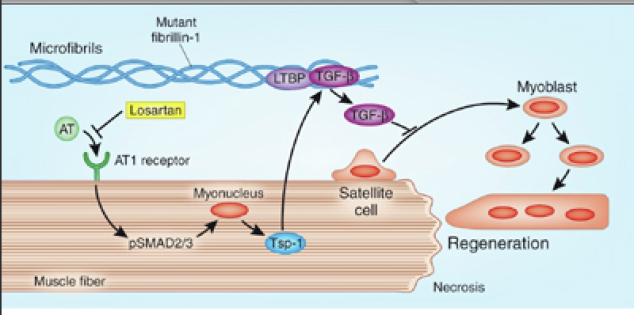This web page was produced as an assignment for Genetics 677, an Undergraduate course at UW-Madison
How does Fibrillin function in the body?
The FBN1 gene encodes for the protein Fibrillin-1. Once the protein is constructed inside the cell, it is then transported outside of the cell into the extracellular matrix where it binds to other fibrillin-1 molecules. These structures then form microfibrils, which make up elastic fibers. Microfibrils hold inactive Transforming Growth Factor-Beta proteins, which are activated upon release and contribute to growth and tissue repair. (1)
Many mutations have been identified in the FBN1 gene that causes Marfan syndrome. These mutations can cause an overall reduction in the fibrillin produced in the cell, alter the structure or stability of fibrillin, or impair the export of fibrillin into the extracellular membrane. This decreased amount of available fibrillin leads to fewer microfibrils and weak elastic fibers. The weak elastic fibers release and overactivate TGFB proteins and can cause Marfan syndrome. (2)
Many mutations have been identified in the FBN1 gene that causes Marfan syndrome. These mutations can cause an overall reduction in the fibrillin produced in the cell, alter the structure or stability of fibrillin, or impair the export of fibrillin into the extracellular membrane. This decreased amount of available fibrillin leads to fewer microfibrils and weak elastic fibers. The weak elastic fibers release and overactivate TGFB proteins and can cause Marfan syndrome. (2)
References
(1) Genetics Home Reference, U.S. National Library of Medicine
http://ghr.nlm.nih.gov/condition=marfansyndrome
(2) Genetics Home Reference, U.S. National Library of Medicine http://ghr.nlm.nih.gov/gene=fbn1
(3) Photo courtesy of Nature Medicine. Retrieved from http://www.nature.com/nm/journal/v13/n2/fig_tab/nm0207-125_F1.html
http://ghr.nlm.nih.gov/condition=marfansyndrome
(2) Genetics Home Reference, U.S. National Library of Medicine http://ghr.nlm.nih.gov/gene=fbn1
(3) Photo courtesy of Nature Medicine. Retrieved from http://www.nature.com/nm/journal/v13/n2/fig_tab/nm0207-125_F1.html
Gabrielle Waclawik
[email protected]
May 13, 2010
www.gen677.weebly.com
[email protected]
May 13, 2010
www.gen677.weebly.com

